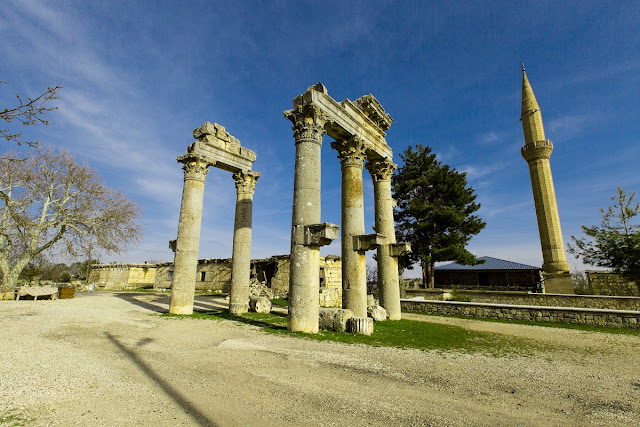Uzuncaburç (Diocaesarea)
One
of the most outstanding monuments of Silifke’s rich archeological heritage is
Uzuncaburç. This site is quite far from the town’s center and you have to take
the road passing through the villages of Demircili, Imamli and Keşlitürkmenli
to reach it.
This
was the sacred site of the Kingdom of Olba. Archeological excavations still
continue here. The Kingdom of Olba was affiliated with the Seleukids.
Under
the Roman domination, the sacred site was separated from Olba and turned into
an independent city. The city was given the name Diocaesarea (Emperor God City)
and it began developing rapidly. The city was surrounded by walls 400 meters by
300 meters. It was embellished by columned streets, the Temple of Fortune,
theaters, sports facilities and fountains. The city minted Roman coins in its
name.
Uzuncaburç
stands at an altitude of 1,184 meters from the sea. The modern settlement has
mingled with the ruins of the antique city. It seems that the antique city is
living a new life in the company of the people of Uzunburç.
Columned Main
Street
The
main street which begins with the Temple of Fortune was built in the 1st
Century A.D. The street cuts another columned street that comes from the
Northern Portal of the city. After this junction we see the Zeus Temple on the
right and the Fountain on the left. Passing under the Ceremonial Portal we
arrive at a theater on the right. The main street leads to the eastern portal
of the city.
The Ceremonial
Portal
The
half-destroyed portal is in front of the coffee house at the foot of a plane
tree. Originally the portal had five arches and it was the place where the
ceremonies were held. However, its architectural elements are preserved.
The Fountain
The
Fountain is a little further up on the right of the Ceremonial Portal. It is in
ruins. In the days of Diocaesarea, water from the source of the Limonlu River
36 kilometers away was flowing from its taps. The water was brought here to the
fountain using a combination of methods like canals, tunnels and trenches. It
is dated to 2nd Century A.D.
The Temple of Zeus
The
temple looks like a forest of columns in a courtyard next to the southern part
of the columned main street. Originally, the temple was an impressive structure
measuring 39.70 meters by 21.10 meters with single row columns along its width.
It is thought that the temple was built at a location where the Hittites had a
temple dedicated to their God of Rain and Storm, Tarhund. In the 5th
Century A.D. the temple was transformed into a church with major architectural
changes.
The Temple of Chance
This is a structure at the beginning point of the
columned main street consisting of 5.5-meter-high, monolithic columns. The
temple is dedicated to the Goddess of Fortune, called Tyche by the Seleukids
and Fortuna by the Romans.
The inscription on it says: “Oppius, the son of
Obrimus and Kyria, the daughter of Leonidas constructed this temple and
presented it to the city.”
The Northern Gate
This is a colossal portal. The inscription on it says
that it has suffered damages during an earthquake and repaired by Arcadius and
Honorius, two sons of Emperor Theodosius.
The Tall Tower
This is in fact a five-story building 22.30 meters
high and measuring 15.70 meters by 12.50 meters in its base with an entrance on
the southern façade. This was the living quarters of the priest-kings of Olba.
It is dated to either the second half of the 3rd Century B.C. or the
first half of 2nd Century B.C.
The figure of this building is found on the coins
minted in this city. Yüksekburç or Uzunburç still retains its symbolic nature
as it the emblem of the town of Uzuncaburç.
The Theater
The theater is situated 50 meters to the east of
the Ceremonial Portal and it has a seating capacity for an audience of 2000 people.
The theater is quite well preserved except for its stage. However, cultural
events are being organized at this antique theater in our day.
Hellenistic tombs, churches and the cemetery dating
back to the Antiquity can also be seen in the town.
Nomads’ Tent
The caretaker of the ruins has set up a Yoruk
tent, named after the Turkoman nomadic tribes who have settled in this region
ages ago and still retaining their traditions, where he serves coffee made of
a local herb called kenger.
It has a different taste. Their ayran,
made of yogurt and water, is also very refreshing. Samples of some local
handicrafts are also displayed and sold on this spot. The young caretaker
seems to be a guy with a special interest in the place he is looking after.
He has photocopied reading material about the ruins and he distributes it the
visitors. He is also very knowledgeable about the archeological excavation on
site. He is very helpful to the visitors.
|

